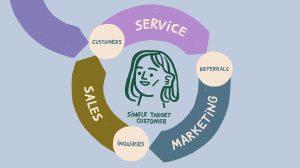Written by Amal Abdalhay
Coupling thought leadership and SEO is challenging but the quality of traffic and inquiries that can come from it are worth it. We teach designers and creatives the same approach and process we use for our clients.
My grandma, Aisha, was a great storyteller. Every Friday, she would gather almost 20 children in her home to impart her wisdom through stories. We called it Aisha’s Tales. She weaved her tales from real-life experiences, boldly offering her insights without asking for anything in return. Over the years, I wondered what made her so good. Now I realize that it was her authenticity and perspective. The way she owned her experiences made those stories so unique.
If Aisha were on social media sharing her stories, we’d call it thought leadership. She’d probably amass a following of respected fans willing to pay for her expertise. At Findable Digital Marketing, we recommend designers do the same with their marketing – share your tales online and create an audience of clients who are willing to pay more for it.
In this article, we will show designers and creatives how to fuse thought leadership and SEO to market themselves, bring in new business and set themselves apart from their competitors.
Jump To
- What is Thought Leadership Content?
- What is SEO Content?
- Can Thought Leadership and SEO Content Co-exist?
- 4 Ways We’ve Taken a Thought Leadership Approach to SEO Content
- Share Your Story. The World Needs More of That
What is Thought Leadership Content?
It’s an approach to positioning yourself as a leader in your industry and an expert on topics your audience considers valuable. Like Aisha, it’s a way to share your authentic point of view, challenge assumptions, make predictions, and provide a framework on various topics.
Examples of thought leadership content are:
- Opinion pieces
- White papers
- Case studies
- Behind-the-scenes
- Experiments
- Original research
It doesn’t matter how long thought leadership content is or where it is. It can be a 140-character post on Twitter, a 2,000-word article in the newspaper or a 30-minute talk at a conference. What makes thought leadership content unique is that it’s by someone who has a level of mastery on a topic and enough expertise to have opinions that are against the grain.
This person has the ability to look at the industry they are in and question what’s going on. They are challenging themselves and others in their field of expertise. They have ideas for solutions, they don’t follow the status quo, and they have a unique vision.
As a designer, you probably have these opinions within your firm. It influences how you do your work, your processes and how you even train your employees. What’s more, is that clients pay you for it. Thought leadership for designers means turning those money-making opinions and expertise into marketing content.
If you want to step into the role of a thought leader with your content, sometimes you will have to say uncomfortable things and upset the status quo. It takes courage to put yourself out there, and you can find so many good reasons why not to do it, like fear of judgment, the spotlight, and your competitors copying your work, and the list goes on. You either let that fear hold you back, or you move past it and show your audience, competitors, and industry your value.
“Thought leadership always creates tension. It’s about making assertions, and you have to be willing to be wrong. You can be certain that people will disagree.“
– Seth Godin
What is SEO Content?
What you see on the first page of search engines like Google, Yahoo or Bing is not random. Someone has either paid to be there or they took the time to understand the algorithm to write content that pleases it. The latter is called search engine optimization (SEO) and SEO content refers to content created with the use of keywords and the intention of ranking on search engines.
For many of our clients, it’s an effective marketing channel however writing content with keyword and for SEO is challenging.
Keywords are the words or phrases users type into Google’s search bar. As a designer, if you want to appear on the first page of Google for the keywords “industrial designer in NYC”, you have to use those keywords in your website content.
Sounding robotic and fluffy is a common when writing SEO content and using keywords. We see it all the time on the web and, in our opinion, this is poorly quality content and unskillful SEO writing. That is why SEO content gets a bad reputation, which leads many to an important question: Does SEO content always have to sounds robotic? How do you create content that bots can read and humans can appreciate?
Can Thought Leadership and SEO Content Co-exist?
Thought leadership and SEO content live on opposite ends of the marketing spectrum. The former satisfies a story, and the latter satisfies a keyword query. Combining the two is challenging.
It’s not easy to articulate your opinion, express it freely and use keywords all at the same time.
You can go above and beyond writing content that incorporates personal anecdotes and well-articulated expert opinions but if it’s not optimized for search engine bots to read, your audience won’t read it either.
As a writer at Findable Digital Marketing, I use a framework to combine thought leadership and SEO.
Using this framework, I write content that is high-quality, this is adds unique insights, points of view and original research, without sacrificing optimization.
4 Ways We’ve Taken a Thought Leadership Approach to SEO Content
At Findable Digital Marketing, we have a process we use with clients to combine thought leadership and SEO.
The first step is defining and articulating their expertise.
This one is challenging because designers and creatives underestimate how unique their opinion and approach is. They don’t realize that what they do or how they think is unique and clever until someone else points it out. We ask clients 4 questions to help pull their expertise out of them.
- Think of a time you did an experiment.
- Have you ever done research first-hand?
- Walk us through the one of your projects.
- Do you have an industry opinion that is controversial?
Once we defined their expertise, we think about keywords that can be a good fit.
Below we’ll show you 4 examples of how we we did this, either for our own content or our client’s.
1. Turn a Casual Experiment into Content
Think of the experiments you have done as an organization. This could be a small A/B testing project or an informal survey over Slack. Sometimes, the experiments and lessons you learn might not seem fascinating, but turn them into content and they could be exciting and spark inspiration in your audience.

Example: Google Ads for Cannabis
Founder of Cannabis Marketing School, Daniela Furtado, knew that advertising cannabis on Google Ads is against Google’s policy yet see often saw agencies casually advertise the service. She decided to do her own experiment to find out what was happening.
Furtado started with a few questions:
- Can cannabis companies advertise on Google?
- What does Google evaluate to approve and display an ad?
- How do I get my cannabis ads approved by Google?
After conducting interviews and researching, she found a loophole in Google’s algorithm and decided to share the experiment online.
She wrote a blog post and she wrote it using the keyword “google ads and cannabis” to ensure the content reached her audience. As a result, the blog post gets over 1,000 page views a month and at its peak, Furtado received an average of 5 emails a week from business interested in hiring her.
By writing about her experiment and using keywords, Furtado coupled her thought leadership with SEO.
2. Share What You Learned From Research
This could be the research you’ve done or would like to do. Typically works best when you need to summarise critical findings after sorting through a large amount of data. Sharing original research shows your commitment to a deeper understanding of your market; it gives you an extra edge and makes you a trusted resource in your industry.

Example: Canadian Guide to Cannabis-Friendly Camping for Highland Cannabis
Where are the cannabis-friendly campgrounds in Canada?
It’s a common question that comes up during camping season but Google didn’t have good answers – which we saw as an opportunity to create content around. We looked for answers and found a large amount of data that we turned into research for our client, Highland Cannabis.
After putting all the data together, we had two ways to integrate SEO:
- Write and optimize the blog post for keywords like “cannabis-friendly camping” or “420 friendly campgrounds”.
- Turn the data into an infographics and press release then pitch it to journalists.
As a result, the blog ranks number one for the keyword “cannabis-friendly camping” in any province in Canada. As a seasonal keyword, it gets thousands of visits to the website in the summer.
We took an extra step and pitched the data and infographics to press and got backlinks from some of the largest online cannabis publications like Leafly and Blazed.
By using keywords when writing the blog post and turning the data-driven content into press material, Highland blended thought leadership content with SEO and digital PR.
3. Take Us Behind The Scenes With a Case Study
Case studies are a strong way to show the transformations you create yet designers don’t show them often enough. By telling people the story behind each project you can show them your process, highlight the value of your work, and position yourself as an expert in your field.

Example: From Nunnery to Family Home for Sansa Interiors
Our client worked on a unique project where she turned a nunnery into a family home. She wanted the project to get publicity, and our team found it great material for a case study.
First, we wrote and published the case study on their website. The keyword volume for “how to renovate a nunnery” is next to nothing so the page doesn’t bring much traffic to their website. However, the nunnery space was a certified heritage home – and that is something people searching for online. We turned the case study into a blog post on how to renovating to a heritage home. The blog post ranks of the first page and drives several hundreds visits a month.
Second, we leveraged the case study for a digital PR campaign to get backlinks. Our client was featured in over a dozen international design publications like Elle Decor, Inside Out, El Mueble, Casa Vogue, and Design Middle East.
4. Don’t Hold Back Your Opinion
Who doesn’t like a good story? As humans, we are drawn to storytelling. And if it was a spicy one and a little against the grain, then we’re all ears. Think about controversial opinions about your design industry, perhaps misconceptions you’d like to break and turn that into a story through content to attract more clients.
Example: How do you price creativity? by Finally Remote Accounting
The accounting firm shared their opinion about something that people need and want to talk about. How do you price creativity? It’s a topic that struck a nerve for so many people. They stated their opinion in a blog post, shared it on multiple platforms, and it eventually got a lot of buzz on social media. As a result of the demand, the blog post evolved into a course that people pay for to learn how to price creativity.
Share Your Story. The World Needs More of That
People are hungry for honest and authentic content; it’s how you can build trust and get them to think of you as the leader in your industry, the designer they want to hire. We showed you how we do it, and we know it works. Now, the decision is yours; you either play it safe and blend in the crowd, or you do what Aisha did – boldly offer your insights and guidance to people around you, and build yourself an audience willing to pay for it. My grandma missed the second part, but you don’t have to!
How to Work with Us
We help design-build firms increase website traffic by 5 times and sales inquiries by 3 times. Hire us to train you on our program, or do it all for you.
Check out the five questions to ask yourself before hiring an agency. If you think we’d make a good team, contact us today!
Amal Abdalhay
Amal Abdalhay is a content writer. With a background in journalism and design, she combines both expertise to plan and write content for all our clients at Findable Digital Marketing. On the weekends, catch Amal between coffee, pastries, family and friends. She is based in Toronto, Canada.
 Personal Branding for Architects and Interior Designers
Personal Branding for Architects and Interior Designers The Good, The Bad and The Ugly of Keyword Data
The Good, The Bad and The Ugly of Keyword Data A Cheat Sheet on How to Write a Service Page
A Cheat Sheet on How to Write a Service Page

